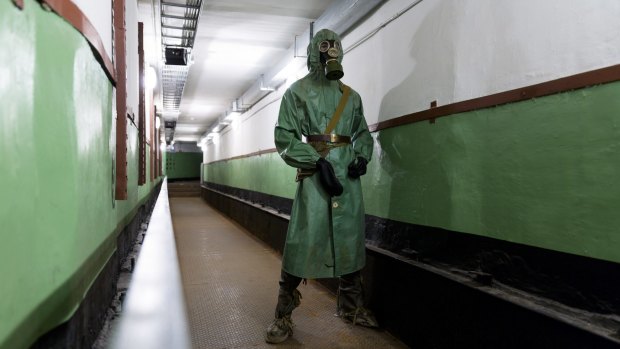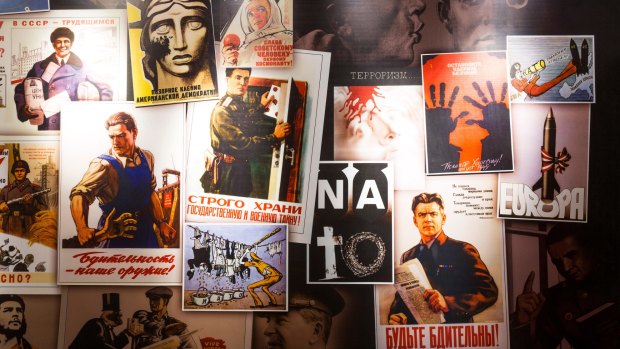This was published 4 years ago
Lithuania, Plokstine: Beneath paradise, a chilling reminder of Europe's brush with the apocalypse
By Alison Stewart

Plokstine, the former nuclear rocket base transformed as a Cold War museum. Credit: Getty Images
These days, the woodlands, meadows and lakes of Lithuania's Zemaitija National park are a natural paradise. But deep in the forest, one of the Soviet Union's first Cold War missile sites is a chilling reminder of Europe's brush with the apocalypse.
From the surface the site, now a fascinating museum, looks like a UFO landing pad with the white domes of the silo lids gleaming in a clearing in the Plokstine Forest. What lies beneath is a sprawling underground bunker system whose business was killing.
There is indeed something disturbingly dystopian about these structures. They housed weapons capable of annihilating a significant part of the world. Four giant R-12 (SS-4) ballistic missiles, 23 metres high (including four-metre warheads) were aimed at countries such as Britain, Norway, Spain, West Germany and Turkey.

Propaganda posters on display at the Plokstine nuclear missile site.Credit: Alamy
Each missile was 15 times more powerful than the so-called Little Boy Hiroshima bomb that killed between 90,000 and 166,000 people.
These missiles were part of the Soviet Union's dark arsenal during the Cold War, a communist-capitalist arm wrestle that terrified the world for 45 years from 1947 to 1991 when the Soviet Union collapsed. Soviet deployments of the R-12 missile in Cuba caused the 1962 Cuban Missile Crisis that almost ended in war. Personnel from Plokstine's 79th Regiment participated in the Cuban deployment.
Plokstine was also on high alert during the 1968 Prague Spring. This brief, four-month period of freedom for Czechoslovakia ended when the Soviets invaded with 600,000 troops.
The Cold War world trembled at the edge of a nuclear holocaust. As pacifist physicist Albert Einstein said: "I know not with what weapons World War III will be fought, but World War IV will be fought with sticks and stones." Einstein regretted how his work facilitated the atomic bomb development.
Writer George Orwell coined the term "cold war" in 1945 after Hiroshima and Nagasaki, referring to the bombs as such a threat they would "create a state which was at once unconquerable and in a permanent state of 'cold war' with its neighbours." He predicted "a peace that is no peace".
We drive inland for 90 minutes from our APT small ship, the Hebridean Sky, docked at the coastal city of Klaipeda, to the museum in north-west Lithuania that lies at the heart of Orwell's "peace that is no peace". Lithuania's gentle, bucolic landscape with its fertile fields, storks' nests on telegraph poles, apple orchards and well-kept farms offers an uplifting counterpoint to an altogether bleaker scenario, not just for Lithuania or Western Europe but for the planet.
By 1959, the Soviet Union and America had produced so many missiles the superpowers could have destroyed the world many times over.
Our guide Ruta Vaskyte is uniquely qualified to tell Plokstine's sorry tale. Her family's story replicates the kind of duress under which Lithuanians laboured during the brutal Soviet occupation.
Ruta's grandfather was one of the 10,000 soldiers forced to hand-dig and build the top-secret base. It took seven months. Her father was to be sent to Chernobyl after the 1986 meltdown disaster as a "liquidator" to undertake the deadly job of cleaning the roof but the Soviets disqualified him just before departure. As an artist, he was deemed "politically incorrect".
A gravel road takes us through pine forest to the base located near beautiful Lake Plateliai. The Soviets chose this area in 1960 for its isolation, elevation – about 170 metres above sea level –and easy-to-excavate soil. They were responding to the US decision to build underground military bases. The arms race was in full swing.
We descend 30 metres into the claustrophobic concrete compound that spreads across rooms, corridors and the vast, six-storey silos. The central control apparatus room with its four missile control panels is recreated based on archival footage. There are displays of weaponry and missile technology, rooms detailing Cold War crises, consequences of nuclear explosions, propaganda strategies and descriptions of base life. Sinister gas-masked mannequins lurk in corridors. A sign boasts, "We are producing missiles like sausages".
The green "button" to launch the apocalypse sits in a cabinet in the commander's bunker. Launch keys and coins produced from missile alloy became popular gifts for former enemies. Personnel could survive for 15 days in normal conditions with the silos hermetically sealed. Fortunately, the "abnormal conditions" scenario went untested.
The security system for this top-secret site involved combat squads, draconian perimeter security, mines, high-voltage wires and alarms. Plokstine remained secret for 20 years. When the Soviets abandoned it in 1978, poverty-stricken locals stripped the base, resulting in many deaths from radiation.
Ruta says the money spent to build the complex could have built a city. "It's frustrating that three of the most poisonous things in life – greed, anger and stupidity – still inspire people. It is my hope that the world's leaders will find peace in their hearts."
TRIP NOTES
Alison Stewart was a guest of APT
MORE
coldwarsites.net/country/lithuania/plokstine-missile-base-museum-of-cold-war-plateliai/
FLY
Singapore Airlines flies daily from Sydney and Melbourne to Stockholm via Moscow and daily from London to Sydney and Melbourne. See singaporeair.com
CRUISE
APT's 13-day Best of the Baltics small ship cruise from Copenhagen to Stockholm starts from $14,995 a person twin share and departs July 2 and July 14, 2020. Price is based on a July 2 departure in a standard suite. See aptouring.com.au/NOBHCS13
Sign up for the Traveller Deals newsletter
Get exclusive travel deals delivered straight to your inbox. Sign up now.